Freshwater aquarium aficionados all aspire to add angelfish to their collection.
These striking members of the cichlid family (Cichlidae) add color and drama to any tank.
Their elegant fins trail behind them as they swim, adding just the right touch of sophistication.
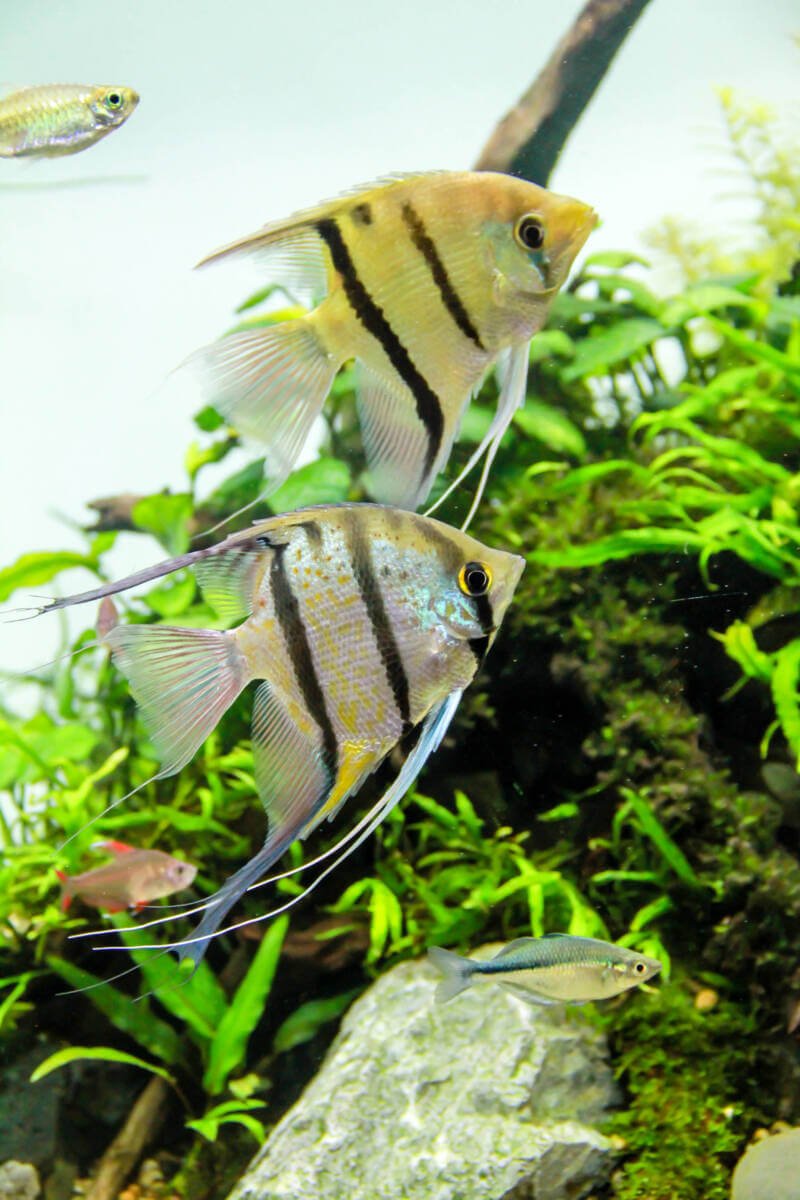
Angelfish come from South America. They gravitate toward tributaries with rich plantings and sandy bottoms.
In the wild, you find angelfish in the river basins of Brazil, Columbia, French Guiana, Guyana, and Peru.
Despite the numerous types, there are only three species: the common (Pterophyllum scalare), the altum (Pterophyllum altum), and the Leopold’s (Pterophyllum leopoldi).
The genus comes from the Latin for “fin-leaf” and refers to its iconic shape.
In this article
Types of Freshwater Angelfish
The different types of freshwater angelfish available today resulted from careful selective breeding.
Aquarists took specific qualities (color, patterns, fin length) and paired them together to create the varieties you find in pet stores.
When you start looking for a specific type, remember adults will have a stronger color than juveniles.
Also, the more dramatic the appearance of your freshwater angelfish, the more prone it will be to disease. Inbreeding weakens a fish’s natural immunity.
1. Altum Angelfish (Pterophyllum altum)
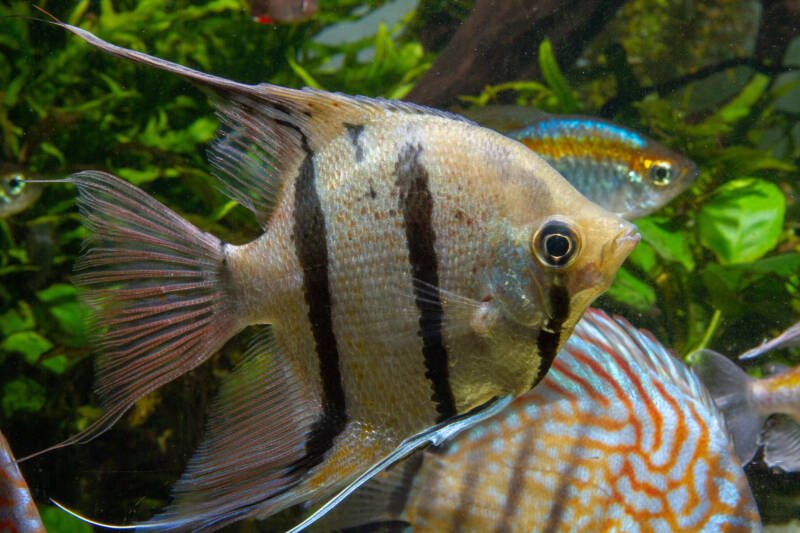
Altums aren’t as common in the aquarium trade. If you have your heart set on one, you may need to research a reputable breeder.
These angelfish are the largest in the group, and they’re usually wild-caught.
You’ll also see them under the name Orinoco angelfish or blue angelfish.
As altums come from the original habitat, they’re more demanding in their tank needs.
You need to bump the heater slightly to 82-90 F (28-32 C), increase the acidity to 4.8-6.2, and keep your water soft (no higher than 5 dH).
The good news is you’ll get a sturdier angelfish than the flashier types. And they still look stunning in an aquarium.
Most have silver bodies with bars of brownish-red.
And as they’re the largest in the group, they make excellent centerpiece fish.
2. Albino Angelfish (Pterophyllum scalare var. Albino)
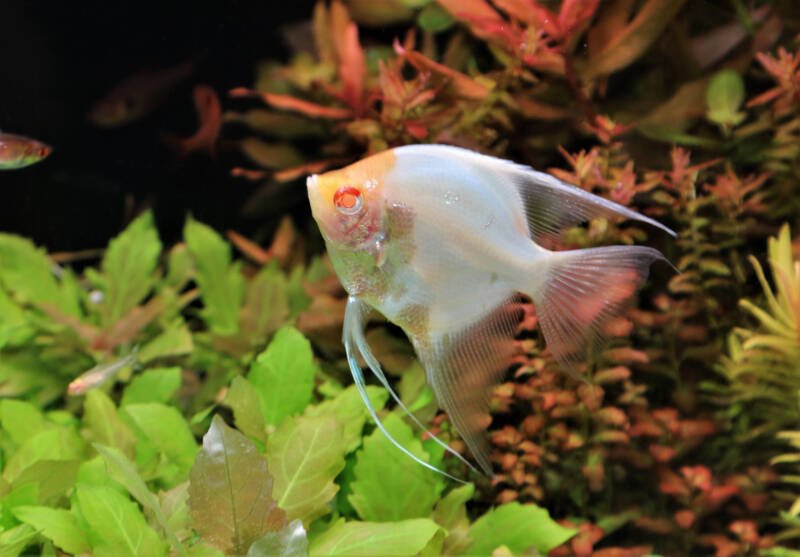
Not everyone wants flash and drama for their community tank. If you want something a little out of the ordinary, the albino angelfish might suit your tastes.
As you can guess, these fish have a complete lack of pigment with stereotypical pink eyes.
If you catch your albino in the right light, you CAN perceive pale gold stripes along the sides. This harkens back to the original angelfish the mutation came from.
That’s right – these fish represent a natural genetic aberration.
Unfortunately, even if you do everything correctly, your albino angelfish won’t live very long.
This type has the shortest lifespan in the group.
Albinos aren’t found in nature often, and they’re incredibly susceptible to disease. So don’t get too attached.
3. Black Lace Angelfish (Pterophyllum scalare var. Black lace)
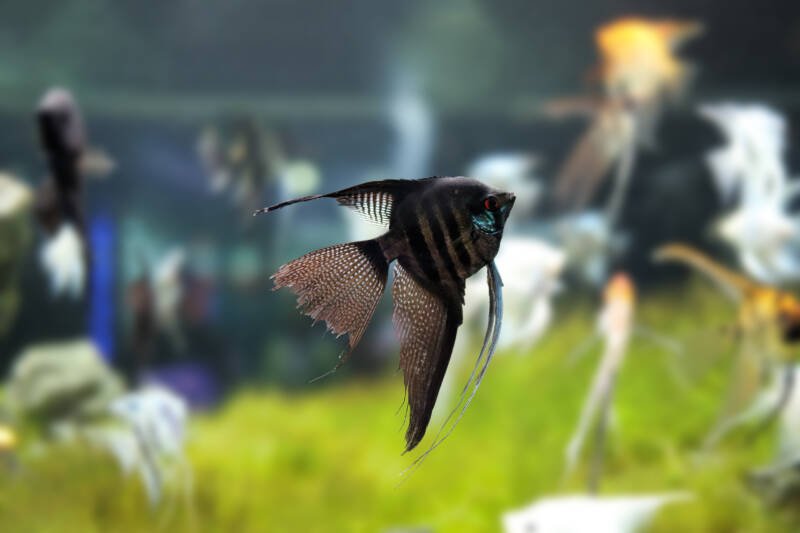
Black lace angelfish came on the scene by carefully selecting silver and zebra angelfish that possessed extra dark genes.
Angelfish that carry a single dark gene fall into the black lace type while those with two dark genes are labeled black, double black, or double darks.
The long trailing fins can reach a height of 14 inches (35.5cm) with proper care.
And if you choose the best lighting, you’ll notice the subtle patterning of those zebra and silver roots the type originated from.
Black lace angelfish aren’t the most active swimmers.
They have a more relaxed temperament, though they’re susceptible to loud noises.
Ensure you keep their aquarium somewhere quiet, so they don’t demonstrate the typical angelfish startle reflex.
4. Gold Angelfish (Pterophyllum scalare var. Gold)
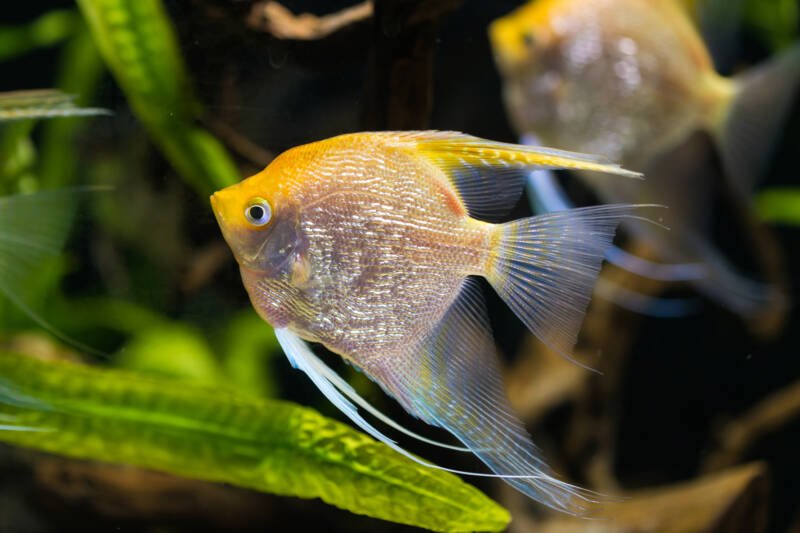
Strange as it sounds, gold angelfish first popped up from a school of black lace fry.
In the 1960s, a breeder noticed a gold fry in the tank. The color was a buried recessive trait that happened to turn up in the batch. Thus began the careful breeding for the gold angelfish.
Golds feature a split pattern of silver and gold (remember, black lace angelfish have silver ancestry).
Juveniles DON’T show the gold, so be patient. That rich golden hue comes in after a year, provided you keep them happy and healthy.
Gold angelfish have long, trailing fins, so consider their tank mates carefully. You don’t want anyone nibbling on them when you’re not watching.
You also want to choose your lighting carefully to bring out the best saturation of their color.
5. Koi Angelfish (Pterophyllum scalare var. Koi)
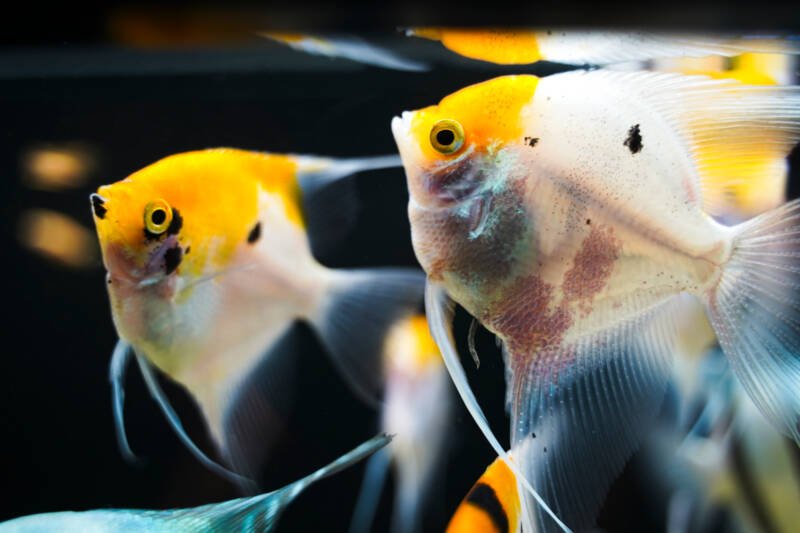
If you love the patterns and colors of koi goldfish, but you prefer to keep a tropical tank, the koi angelfish solves the problem beautifully.
You get the same shades of white, orange, and gold, but on the flattened angelfish body.
Juvenile kois carry a red patch beneath their eyes. This patch gradually fades away as they age, though, so don’t get attached.
Some koi angelfish have patches of black, mimicking the marble angelfish, though they lack stripes.
Koi angelfish change color depending on their mood. As they become stressed, the orange tone gets darker.
It sounds cool, but it’s a warning sign you want to keep an eye out for. If you notice color changes, it means it’s time to check on your fish.
6. Leopard Angelfish (Pterophyllum scalare var. Leopard)
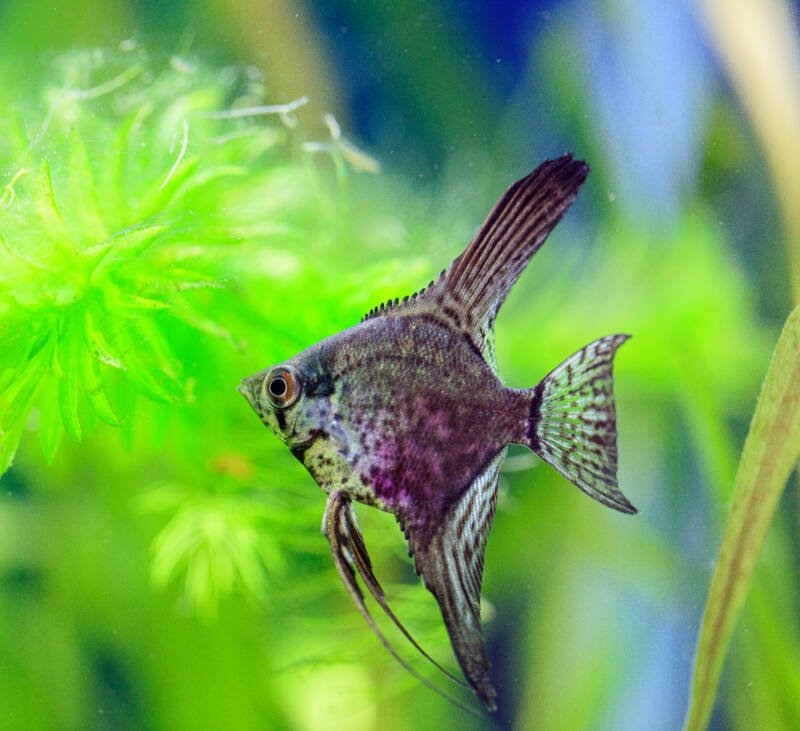
Leopard angelfish trace their roots to common angelfish.
Natural spotted patterns occurring in the wild were combined with captive-bred fish to yield angelfish with spots on their sides rather than the usual stripes.
There’s a catch to leopards, though. If you want those spots to remain clear and dazzling, you need to keep the lighting as close to natural as possible.
If you overdo it (or underdo it), the spots fade, and you’ll end up with an angelfish that looks smoky.
You’ll find a lot of variations in the spots with your leopard angelfish. They’re also hardier than some of the more inbred types.
If you’re up to the lighting challenge, leopards make an excellent choice for freshwater aquariums.
7. Marble Angelfish (Pterophyllum scalare var. Marble)
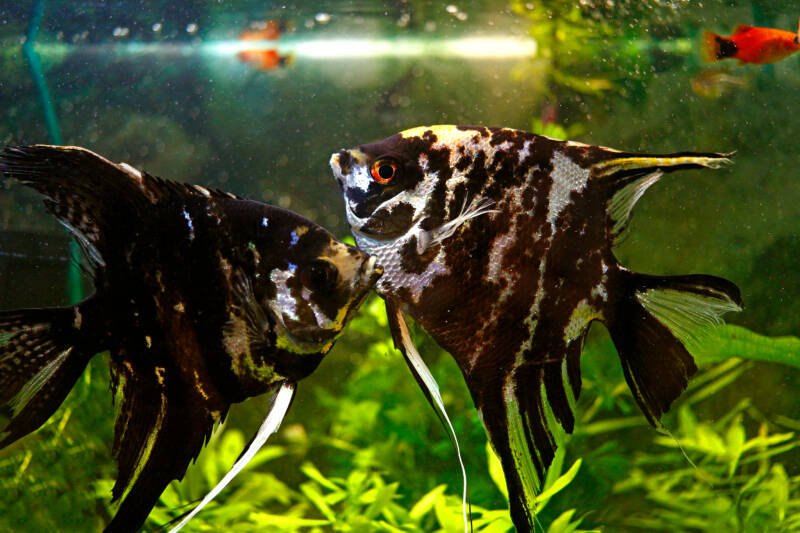
Marble angelfish combine the best features in one.
They have fins that aren’t too flowing to tempt nippers, with swirling patterns in black, white, orange, and silver.
No two fish are alike, either, allowing you to set up shifting colors within the tank.
Marbles share strong genetics to the common angelfish. Which means you get a sturdy fish that isn’t susceptible to disease.
Breeders didn’t need to do any dramatic inbreeding to achieve the beautiful patterns, leaving you with a healthier fish.
Marble angelfish are also the most commonly sold type. You find them readily available in pet stores.
They tolerate temperature fluctuations better than other freshwater angelfish, even if they’ve been captive-bred.
8. Silver Angelfish (Pterophyllum scalare var. Silver)
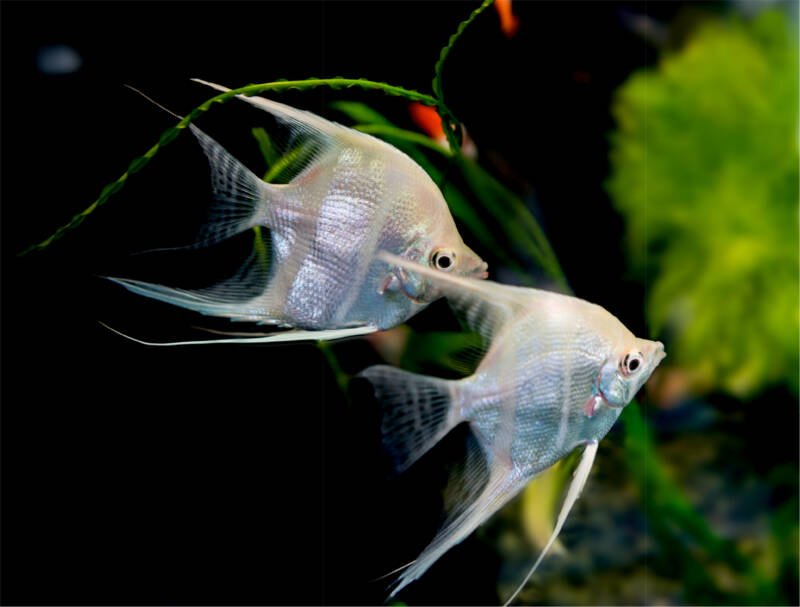
The silver angelfish most closely resembles common angelfish.
They serve as the original genetic material for most of the other types aquarists clamor for.
They’re also the hardiest and easiest to care for, making them the top choice for novices.
Silvers have (you guessed it) silver bodies with three distinct dark stripes.
One stripe goes through the eye, with the other two down the body.
Similar to the koi angelfish, their colors fade or darken as their mood changes, so keep an eye on them.
Silver angelfish enjoy variety in their diets, the same as other types of freshwater angelfish.
However, if you choose to incorporate mosquito larva, take it easy.
They’ll try to gorge on them, and overeating causes silvers to build up fat and become inactive.
9. Veil Angelfish (Pterophyllum scalare var. Veil)
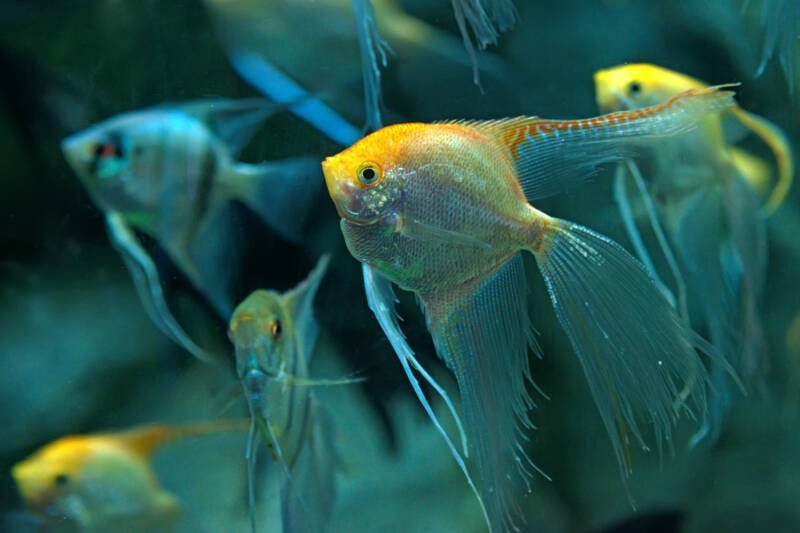
Veil angelfish rank at the top for popularity among types of angelfish. Who can resist those sweeping, elegant fins?
Over 40 years of selective breeding have created the over-the-top fins available in every color and pattern you could want.
The “veil tail” gene provides a couple of options.
A single gene yields the typical veil angelfish. Two genes produce even more elaborate fins (if you can imagine it), and the type of a super veil angelfish.
Unfortunately, dragging those fins around comes with a price.
Veils swim MUCH slower than other angelfish. This makes them more prone to fin and tail rot.
Not to mention so much flowing fin is hard for nippy tank mates to resist.
10. Zebra Angelfish (Pterophyllum scalare var. Zebra)
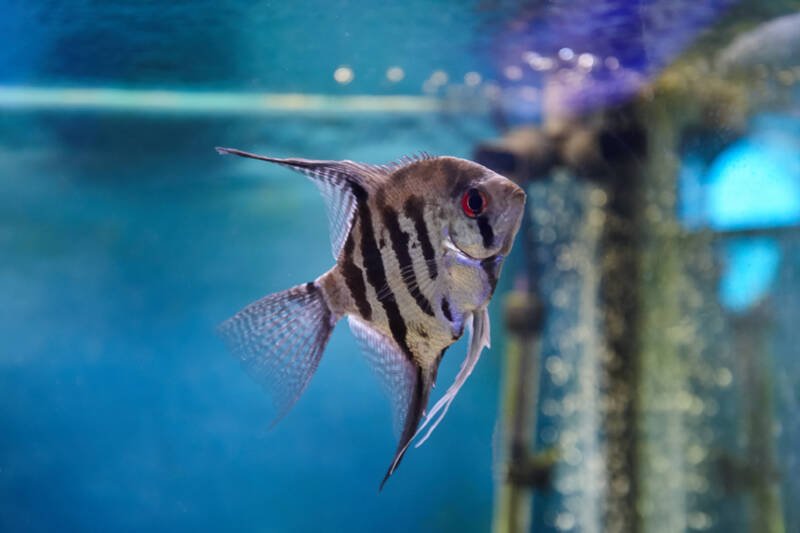
Several freshwater angelfish have stripes (their type originated from the silver angelfish).
In contrast, the zebra angelfish has four to six stripes across the body, including the one through the eye.
The extra lines are what distinguish them from the others.
Zebras are a little smaller than some of the other types. They’re also a little faster and more active swimmers.
Keep that size in mind when you place them in a community tank, as you don’t want them to end up bullied by a larger fish.
Some fully mature zebra angelfish develop red eyes. You won’t always see it (so don’t get your hopes up).
You’ll maximize your chances by keeping water conditions and lighting at their best.
And make sure you’re patient – juveniles DON’T have red eyes.
Freshwater Angelfish Behavior
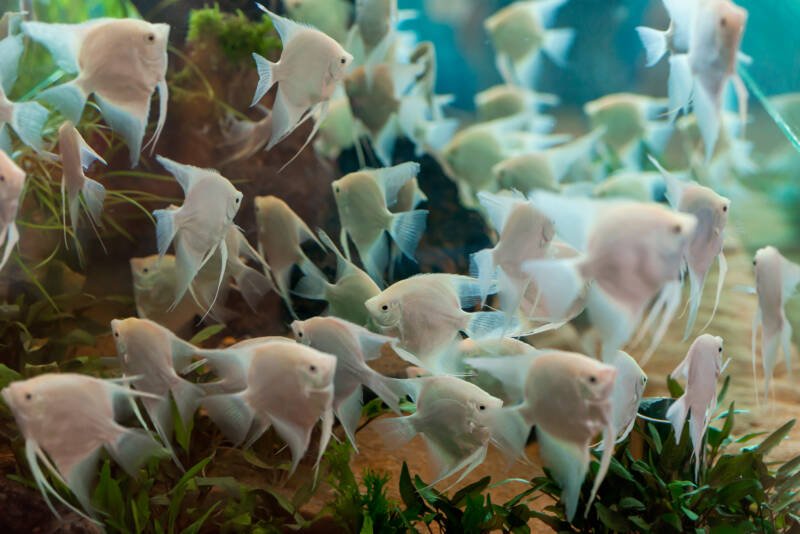
They may have the word “angel” in their name, but freshwater angelfish are far from peaceful.
Remember, these lovely fish ARE cichlids! They have semi-aggressive natures.
And that aggression amps up with age, overcrowding, and small tank size.
Angels with Angels
Angelfish don’t need to stay in schools the way other colorful freshwater fish do.
As a matter of fact, they’re perfectly content as the lone peacock in the group.
If you choose to keep a school, make sure you have a large enough tank to give everyone room.
It may look enchanting, but when two angelfish “lock lips,” it isn’t a sign of affection. That’s a dominance display.
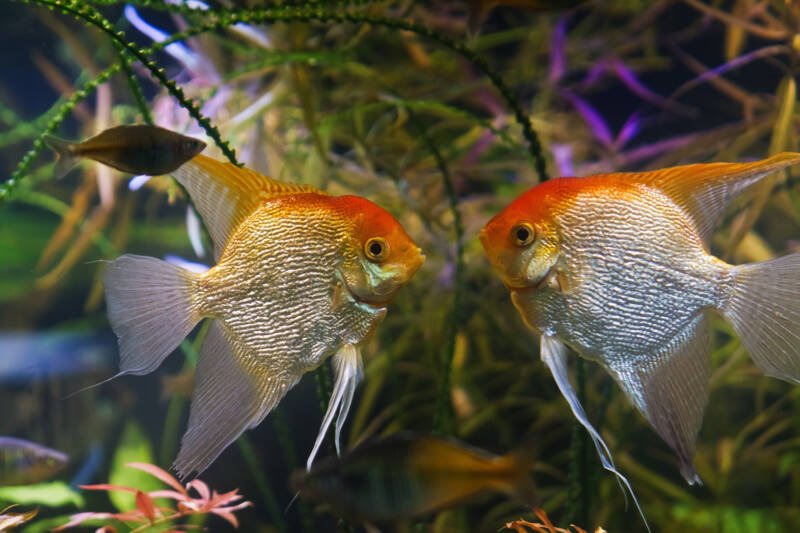
Angelfish establish territories, and they fight to defend the space in the aquarium they’ve chosen as theirs.
You CAN keep a pair together if you’re interested in breeding your angelfish.
Unhappily, telling the sexes apart isn’t easy—males AREN’T brighter in color than females.
If you end up with a happy pair, though, you’re in luck: angelfish mate for life!
Tank Mates
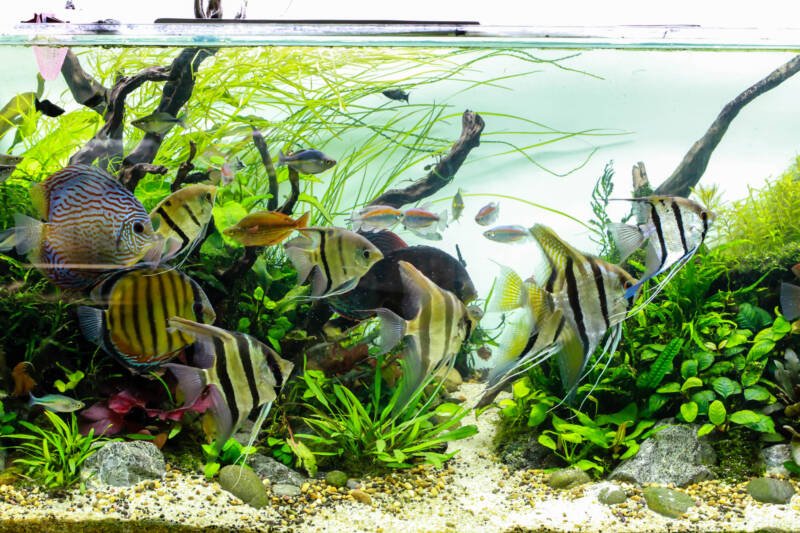
The same sweeping fins that make freshwater angelfish so popular can also make them poor choices for a community tank.
Many fish – such as bettas, guppies, goldfish, and oscars – can’t resist taking nibbles out of those fins.
Luckily, there are plenty of tank mates that can mind their manners. Just choose sizes appropriately.
Remember, you’re dealing with a cichlid. You don’t want your angelfish to snatch up their tank mates as a snack.
- Bala shark
- Corydora
- Dwarf gourami
- German blue ram
- Kuhli loach
- Molly
- Platy
- Plecostomus
- Swordtail
- Tetras
Keeping Freshwater Angelfish

Freshwater angelfish present an easy to moderate challenge for aquarists.
As cichlids, they have a hardy nature. However, their shape, behavior, temperament, and diet present a few challenges.
A beginner CAN handle angelfish, provided they do their homework.
Setting up the Tank
The first task of managing angelfish is selecting an appropriate tank. Freshwater angelfish grow TALL.
Most types can reach 10 inches (25 cm) in height. This means you need to look at ALL of your aquarium’s dimensions.
A single angelfish will do well in a 30-gallon (114 l) tank. The length should be at least 30 inches (80 cm), and you need a width of at least 19 inches (50 cm).
If you plan to have a pair, scale up to 55 gallons (208 l).
Want an entire school? You’ll need 80 gallons (303 l).
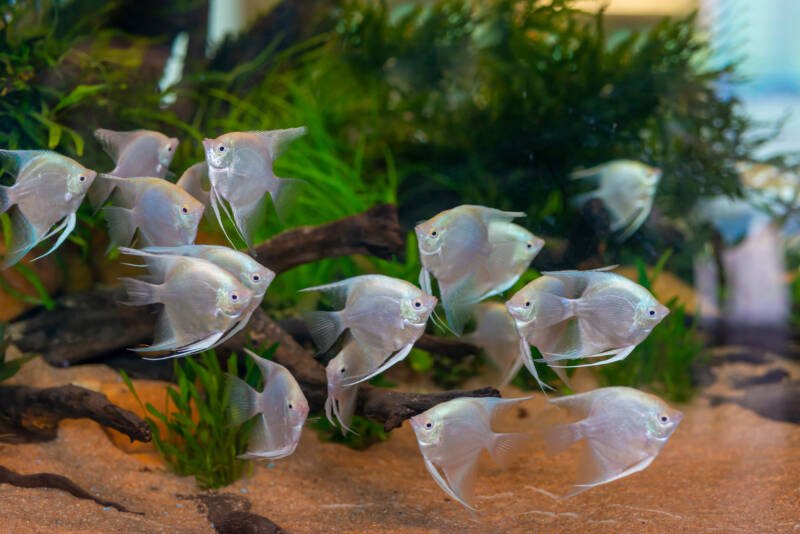
If you try to squish your freshwater angelfish into a small tank, you’ll create overly-nervous fish.
Angelfish already have skittish natures (they panic at shadows).
Shallow tanks heighten that negative stress, and stressed fish succumb to the disease.
Just Like Home
Angelfish in the wild inhabit river basins and tributaries lined with natural plant growth.
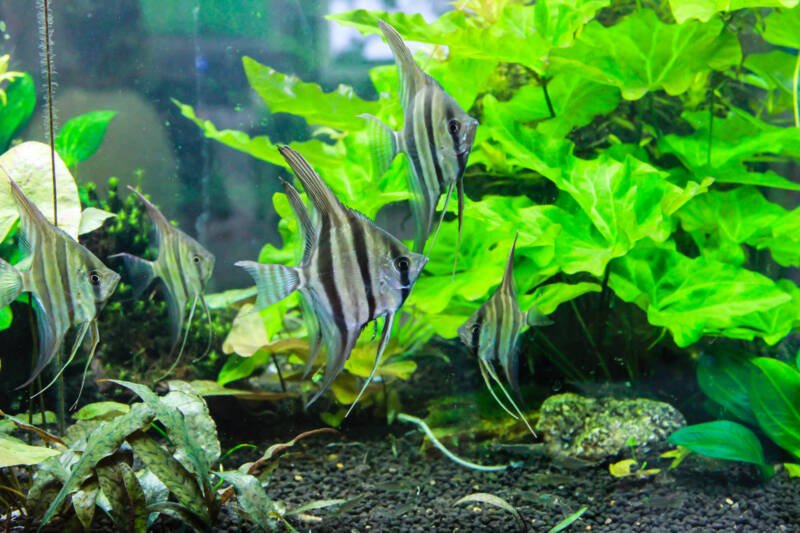
To provide shelter and block sudden shadows, try to include as much plant life as possible in your tank. Common choices include:
- Amazon grass
- Amazon sword
- Brazilian pennywort
- Melon sword
- Water stargrass
- Watermilfoil
These plants come from the Amazon River Basin – one of the native areas wild freshwater angelfish come from. They’re easy to manage, and they look great in your tank.
If you choose a colorful type of angelfish, they’ll also help the colors stand out.
Water Quality
Angelfish look ethereal and delicate. Luckily, their water quality needs aren’t as demanding as their appearance suggests.
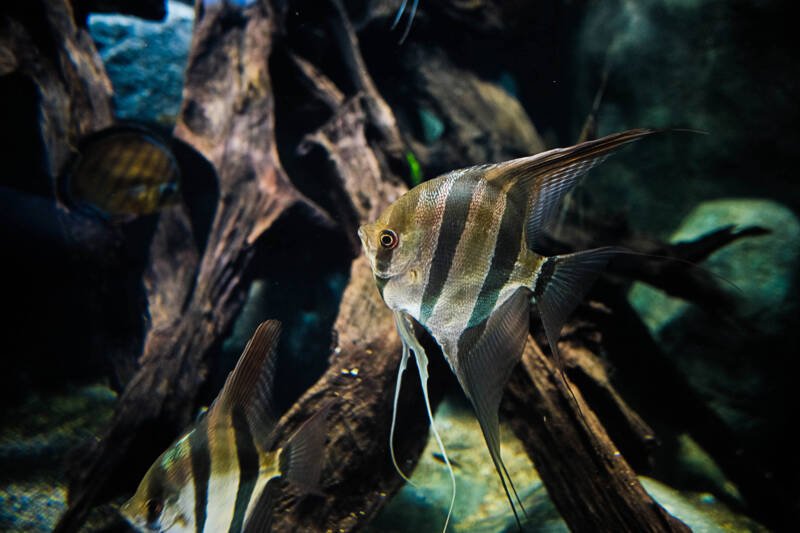
While they ARE tropical species and require a heater to keep the tank at an appropriate temperature, you won’t need to do too much work to keep them happy.
| Parameter | Range |
| Temperature | 76-84F (24.4-28.8C) |
| pH | 6.0-7.0 |
| Water Hardness | 3-10dH |
| Nitrites | 0ppm |
| Ammonia | 0ppm |
| Nitrates | <20ppm |
Food and Diet – What’s on the Menu?
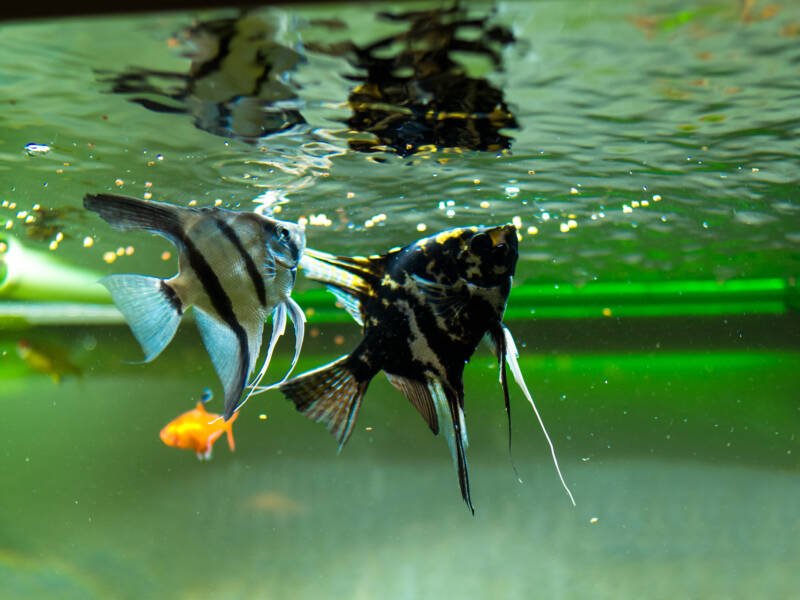
Officially, freshwater angelfish are omnivores. However, they lean a little closer to the carnivore side of things.
If you want to keep them healthy, and have those colors stay vibrant, keep the diet as varied as possible.
Choose the highest quality foods. Cheap foods contain poor sources of ingredients, and your fish usually can’t digest them properly.
This results in excess waste in the water and higher chances for infection. So stick to the best sources and rotate the diet:
- Blanched vegetables
- Bloodworms
- Brine shrimp
- Cichlid flakes
- Cichlid pellets
- Mysis shrimp
- Plankton
- White worms
Freshwater Angelfish Health
Cichlids, in general, tend toward the healthy end of the spectrum.
If you don’t keep up with regular tank changes or source quality food, your freshwater angelfish can become stressed and develop infections.
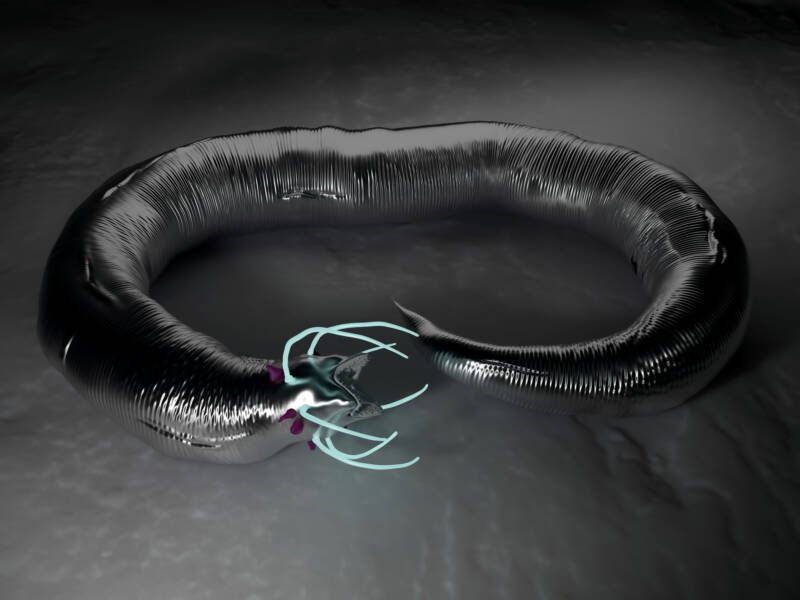
Two parasites, in particular, crop up in freshwater angelfish:
- Nematodes: The eggs and larva enter the tank on poor quality food. Once ingested, the roundworm develops within its host over three months. You’ll see weakness, inflammation, and bleeding. Nematodes spread quickly, and they CAN be fatal.
- Hexamita: This protozoan also enters angelfish through ingestion. It targets the intestines and gallbladder, causing weight loss, weakness, and loss of color.
Both parasites CAN get treated with medication. If you notice symptoms, isolate the affected fish to prevent your aquarium from possible infestation.
Always clean foods thoroughly, and make sure you have a regular tank cleaning schedule.
Also, stay on the lookout for ich (white spot disease). It affects angelfish frequently, causing loss of swimming ability, appetite, and proliferation of parasites.
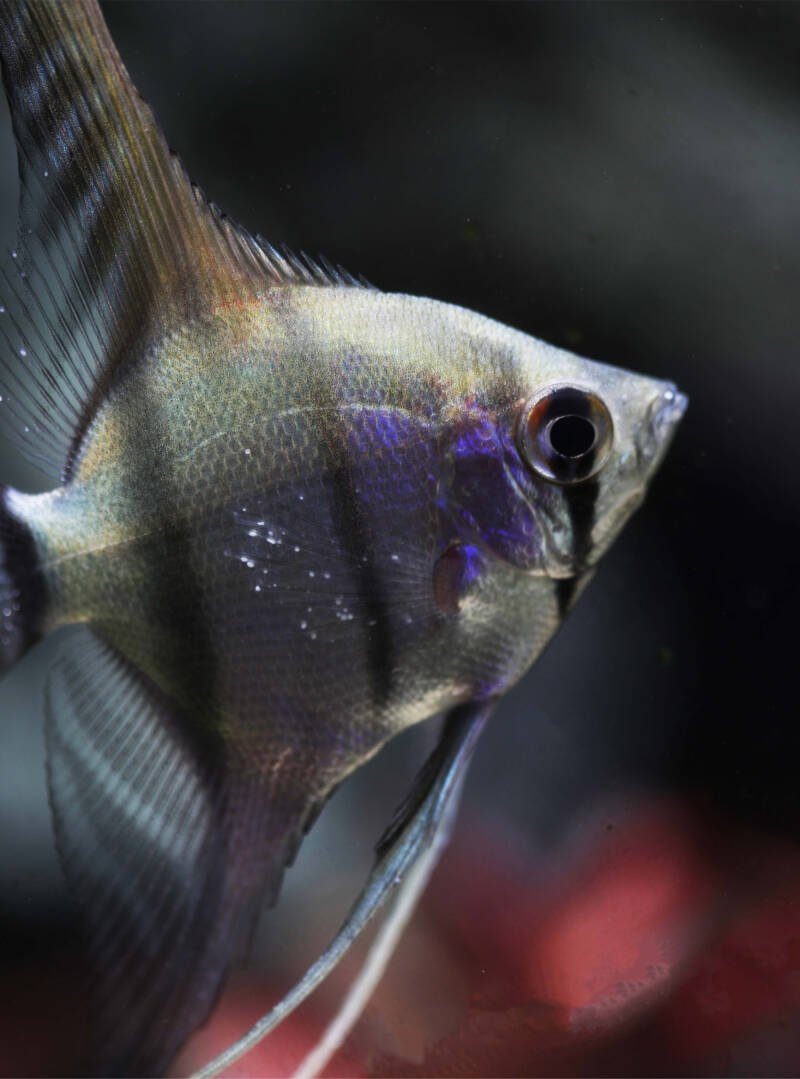
Freshwater Centerpieces
Aquarists love incorporating freshwater angelfish into their community tanks.
The long, sweeping fins and dazzling array of colors and patterns add a touch of elegance to any aquarium.
These fish are relatively undemanding in their care, and they’re easy to obtain. It’s the best of both worlds!
Do you keep freshwater angelfish? Which types are your favorite? Tell us here!